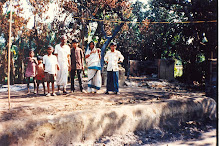Brasilia, Brazil
Sachi G. Dastidar
In September of 2019 Shefali and I took a trip through Brazil. Our
first stop was at Brazil’s Amazon Rain Forest, then to the newly-built capital
city of Brasilia, followed by a trip to Iguassu Falls of Argentina and Brazil,
and on the beautiful city of Rio de Janeiro. Iguassu is a junction of three
nations: Brazil, Argentina and Paraguay. Thus we journeyed to the Argentinian
side of the Falls, then made a brief trip to the Paraguayan border city of
Ciudad del Este.
If one lands at Manaus, the center of Amazon and the capital of
Amazonas State, as we did, one may not realize that one is landing in the
middle of a forest, as Manaus is a huge metropolis of 2.3 million people with
freeways, skyscrapers, theaters, hotels and restaurants.
These days we hear a lot about fires in Amazon. There was none
in the Metropolis. But we witnessed small fires set by residents during our
road trip to our jungle lodge, as well as when we flew over the forest going to
Brasilia. Most of the fires are at the edges of the forest as people were
land/forest grabbing at the edges going towards the center. Manaus is at the
center of the forest area, hundreds of miles from the border forest
fire/cleansing.
An added pleasure for this travel was that many Brazilians
looked like us, thus many locals took us for “locals” until we said something.
Then there were some who were confused learning that we Indians were not
traveling from India, but from the United States.
Brasilia is the
modern, futuristic, planned city in somewhat center of Brazil. We read about
the city plan by Lucio Costa and its principal architect Oscar Niemeyer at our
architecture and planning classes. Seeing Brasilia will be a wish come true.
Although in 1890s it was proposed to have a new capital, yet it was built by JK
or President Juscelino Kubtischeek de Oliveira who governed Brazil from 1956
till 1961. This was Brazil’s 3rd capital after Salvador and Rio de
Janeiro. It is one of the largest cities of the country with broad streets,
land use carefully separated, tall buildings, and a low density as in many
newly-built cities around-the-world. Thus there are sectors for government
offices, private businesses, education, hotels, etc. Private residences for
low-income population is located far from the main areas. The city plan looks
like an airplane. Brazil in a unilingual nation, thus very few people spoke
English, although many understood Spanish or French with Latin root. Yet they
were eager to help strangers.





























No comments:
Post a Comment